Articles by Pierre G. Harmant
Anno Lucis 1839 (1/3)
Eighteen hundred and thirty nine
Anecdotal history of photography by Pierre G. Harmant
Keeper of records of the Société Française de Photographie
I
People are inclined to think that the annals of the 'new art' of photography are too short for anything to have happened but History, plain and simple, with its lists of events, dates, names of people and processes. Thus, after the works that have been written in this field by our worthy predecessors, whatever their omissions, gaps or even prejudices, we have turned our thoughts to writing what others would term "minor history'.
Legendary tales, oral traditions and also peeps behind the great set scenes of History never fail to shed new light on facts which one historian passes on to the next by means of successive copies of the same source.
In the accounts which we are venturing to give here, we have endeavoured to lend a differently attuned ear to facts which seem to have had too little attention in the past, always taking care, however, to relate them to what is verifiable, to solid pieces of evidence deposited here or there. Hence what we shall preset here is not necessarily a chronological sequence of the facts recounted by others in more knowledgeable detail than we can supply, but slices taken from the private life of the leading protagonists in this great adventure of photography or its natural extensions, cinematography or reproduction processes.
Invariably we shall give the source of unexpected, astonishing or amusing information, in the hope that this mode of presentation, while interesting the reader, will also enable him to fix events and personalities in their context better than the cold and didactic account of an encyclopaedia which is necessarily congealed in the past.
Pierre-G. Harmant
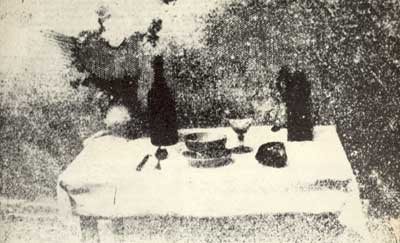
Helioraphic picture made by Nicéphore Niépce. The original, now destroyed, was on glass. It belonged to the Société Française de Photographie, where a negative enabled the memento seen here to be preserved.
At an ordinary meeting of the Academy of Sciences held in Paris a little over 120 years ago, there was what might be truly described as an explosion. On that Monday, January 7, 1839, Arago, the famous astronomer and politician, disclosed to his colleagues that a Frenchman had succeeded in fixing permanently the pictures formed in the camera obscura and that his secret would be made public without delay 1.
If the periodicals of the time are to be believed, this extraordinary announcement created a great stir. The excitement ran high, not only in artistic and scientific circles, but also amongst the general public, who seemed dimly aware of the great importance of this discovery. Indeed it was just as if an old dream was suddenly becomming true: it would be possible to record the fleeting moment, bring back pictorial souvenirs of distant journeys, make a map of the sky, and do the thousand and one things which occupy the minds of sketchers, draughtsmen and all thoses whose job it is to turn out nothing but scrupulously accurate reproductions of reality.
Today nobody will dispute France's claim to have given birth to this 'new art', as it was called at the time, this miraculous auxiliary of the modern Sciences and Arts; but if nobody dreams of putting other names before Nicéphore Niépce and Louis Jacques Mandé Daguerre, there were many historians, each in his own country, who sought in the archives the names of those fellow countrymen of theirs who might be found a small place in the shadow of the creators of photography.
Then (perhaps this was a peculiarity of the year 1839) something happened which is probably unique in the history of a discovery: there appeared out of thin air, from the moment Arago's communication was published, a whole crowd of investigators who claimed, in all sincerity, to have solved the same problem, viz. that of fixing pictures in the camera obscura. On reading the papers of the time (those dated 1839 alone) one is almost overwhelmed by the flood of news from every quarter. Certainly 'the idea was in the air' as they say, and we shall see that the solutions put forward were sometimes original.

End of the report written by Nicéphore Niépce at Kew, when staying in England, in the hope of having it brought to the notice of scientific circles, published in the 'Photographic News' of May 23, 1884.
I have had an amusing time picking out of the daily papers as well as the scientific journals the names of all those who were anxious to publish their solution and who, without exception, claimed of course to have been ahead of Daguerre. This induced me to draw up brief statistics as follows: Twenty-four persons claimed to have been the inventor of photography as from 1839 and can be grouped thus:
Seven Frenchmen: Niépce, Bayard, Daguerre, J.-B. Dumas, Desmarets, Vérignon, Lassaigne; six Englishmen: Talbot, the Rev. J. B. Reade, Herschel, Fyfe, Mungo Ponton (to the English section of this list there should perhaps be added a mysterious ecclesiastic who goes under the pseudonym of Clericus); six Germans: Steinheil, Kobell, Breyer, Hoffmeister, von Wunsch, Liepmann; an American: Samuel F. B. Morse; a Spaniard: Zapetti; a Norwegian: Winther; a Swiss: Gerber and finally a Brazilian: Hercules Florence.
Quite a list for a single discovery in so short a time! All the same, we must allow that each of them had good reasons for believing he had solved the problem.
The position at the beginning of January 1839
Before allotting each his particular place, it must be said that very few people, even in learned circles, suspected that the problem had already been solved, or rather, they had forgotten the work of Nicéphore Niépce. In 1827 Niépce had conceived the idea of interesting the members of the Royal Society of London in some engraved metal plates and some curious patterns obtained simply by the action of light on certain varnishes. This process, called 'heliography' by its inventor, was not described explicitly enough in the memorandum accompanying the sample, and the learned English society refused to take cognizance of it. All the same, Niépce left in the hands of his English host, the botanist Francis Bauer, who was himself a member of the Royal society, the fruits of his work and returned to France. More than ten years went by, but everything was forgotten... or almost.
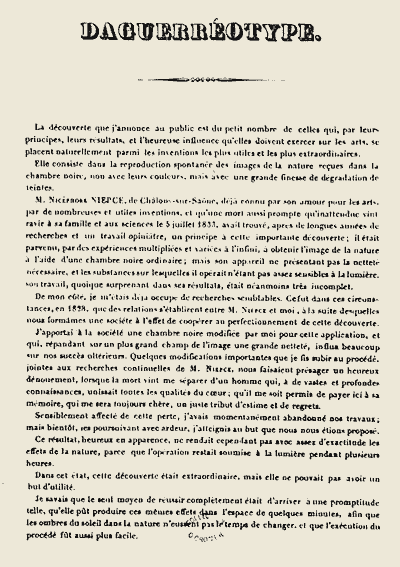
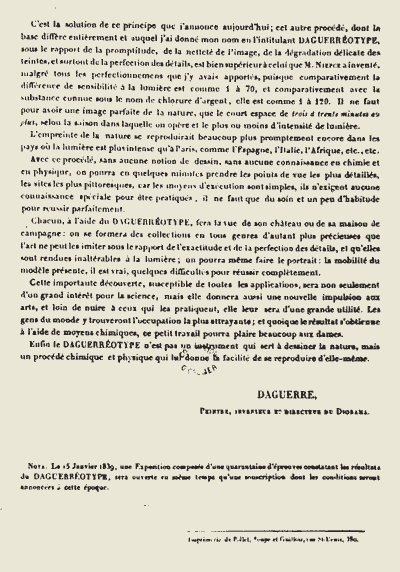
Pamphlet published by Daguerre at an uncertain date (but before the disclosure made by Arago in January 1839).This text, discovered by Gabriel Cromer, is now in the collection of the George Eastman House, see Image, March 1959, p. 33.
In France a certain Daguerre, much better known at that time as a scenic painter and director of the Diorama at Paris, who could captivate the crowds with the skill of his paintings, entered into an agreement with Niépce in 1829 2. He thus became privy to his secrets and immediately set about solving the difficult problem which his partner still considered to be very incompletely explained. Unfortunately Niépce died in 1833, and Daguerre, now alone, found his interest directed (solely by a beneficent chance according to him) towards exploiting two curious things he had noted: the light sensitivity of silver iodide and the appearance of the latent image under the influence of mercury vapours. Taken in conjunction these two facts led him to the process which is called, after him, daguerreotypy.
Did he keep his invention do himself? Not altogether. Even though his new associate, Isidore, the son of Nicéphore Niépce, never had full knowledge of the technique used, Daguerre thought fit to speak of it on several occasions, in veiled terms in the 'Journal des Artistes' 3 of September 27, 1835, then more openly at the end of 1838 in a sort of publicity prospectus 4. He volunteered to disclose the secret when a subscription had brought funds to an adequate level, but French, being mistrustful, did not respond and held aloof 5
Realizing very soon that this appeal to the French purse was not going to succeed, Daguerre decided to seek another backer: Science. He was to succeed, perhaps beyond his wildest hopes, by finding as his spokesman the most ebullient and enthusiastic of the Academicians, Domnique François Jean Arago, who had the additional advantage of being deputy for the Pyrénées Orientales. But another scientist, a colleague of Arago's, seems to me to have been fully acquainted with Daguerre's solution. This was Jean-Baptiste Dumas and we shall see later what opinion we are justified in forming of his part in the story.
After the thunder-clap of January 7, 1839, no one dreamed of disputing the competence of Arago: he gave his assurance, without revealing anything, that Daguerre had succeeded in finding the solution. Thus nobody doubted the reality of the fact or thought that he might have been deceived by some amusing optical trick or that the products were not in strict agreement with what he announced. So Arago was believed, all the more readily because everybody thought that the dream would very soon become reality without really knowing why or, more especially, how. Moreover, since nothing had been said of the methods employed and only the result had been described, and in every civilized language, the fever of excitement became pandemic...

Extract from the researches of Schulze on silver salts. The passage marked int he margin has been translated into English, since it appears to be the most characteristic part.
(...) and I covered the greater part of the glass with opaque bodies, leaving a small part exposed to the light. Several times I wrote words or whole sentences on paper, and after having carefully cut out the inked parts with a sharp knife I stuck the paper, thus perforated, on the glass with the aid of wax. Before long the rays of sunlight which impinged on the glass through the apertures in the paper wrote the words and phrases so accurately and distinctly on the chalk deposit that many people, interested in these matters, but in ignorance as to the nature of the experiments, were led to attribute the result to all sorts of tricks.
New names were put forward here and there, either from a simple desire to attract attention or for more valid reasons on which the claimants based the priority, if not also the superiority, of their methods, Arago's statement therefore must be regarded as a crack of the whip, as a stimulus, which determined the waverers and the faint-hearted to show their hand, even though their products were very far from being considered perfect.
The disclosure by Daguerre of his process was conditional upon purchase by the French government and this required the sanction of the Chamber. This was to result in a delay in the publication of the details essential to carrying out Daguerre's method lasting until August 19, 1839. During this period of waiting the inventors mentioned in the foregoing grew impatient and fretful... not to mention those whose names do not appear in our list.
With an invention as important as photography, it is quite normal for each nation to seek amongst its great men those who might be able to share the glory of having brought about the final success. But one must not fall into what seems to be the error of J. M. Eder, and confuse, as he does in his remarkable 'Geschichte der Photographie', photochemistry and photography. This is mentioned to eliminate all those who, at some time or other, discovered that light can act upon a body, either by modifying its physical aspect or its chemical properties. Thus it seems far-fetched for anyone (after taking the trouble to read the account in Latin 6) to admit the experiment performed by Dr. Schulze as anything but an entertaining piece of physics.
It might be said that there can only be photoggraphy if there is a permanent recording (relatively speaking of course) of images obtained by the action of a particular radiation. Thus, interesting though they are, we must eliminate the experiments of Tom Wedgwood and Davy, since these authors were unable to fix their results 7, and for the same reason, we cannot include the silhouettes of the physician Charles 8.

First page of Davy's memoir recounting the experiments of Thomas Wedgwood.
Many people believe that they have found sensational prophetic references in early writings. They have no doubt been led astray by their enthusiasm and do not appear to have applied the strict objectivity called for in their commentaries. Tiphaigne de la Roche 9 and Fénelon 10 did not invent photography, any more than Cyrano de Bergerac, in another sphere, can be considered the forerunner of magnetophone and [added by PGH on his own issue, webmaster's note] interplanetary travel. It does not do to confuse the description of a dream with its material realization.
Antonio Cello 11 discovered nothing in this field, and Gonord did not make use of photographic enlargement in 1819. The first was content to describe and the second, contrary to what may be read in all the histories of photography, did not take his secret with him to the grave: it is described in a French patent dated July 18, 1818.
Alléon Duval 12 did not discover light-sensitive glasses in 1765 and there is no doubt that Gaumé 13 did not think of making photographs by using a process of decolouration by light in 1827... I realize that certain idolatries may be shaken by taking this view of things, but first and foremost it is a question of restoring to those who deserve it their real claim to glory, viz. of having put forward the results of their own work in competition with the Daguerre process.
One point remains obscure to many historians. Who was the unknown man, who, one day in 1826, showed to the optician Chevalier positive images on paper? In a book devoted to the memory of his father, Arthur Chevalier, relates the story 14. He accurately describes the views which were placed before his eyes and mentions that the 'poor young man' who had called gave him a bottle of the 'liquid' he used so that he could try it out. It would be easy to dismiss this as just another legend about photography if it were not for the fact that one day I was surprised to discover in the papers Hippolyte Bayard bequeathed to the Société Française de Photographie certain views, obtained by several methods, which are strangely like the descriptions given by Chevalier. Nor is this all: the Mayor of Breteuil-sur-Noye (in the Oise) who lives in the house where Bayard was born, has been kind enough to forward to me a letter from a descendant of Bayard declaring that he was the unknown man, but that the meeting took place in 1830 15. Bayard never mentioned it, and Chevalier, who knew Bayard, kept silent on the point without our knowing the reason. No one, with the exception of Hubert 16, made a spectacular appearance on the scene before 1839.
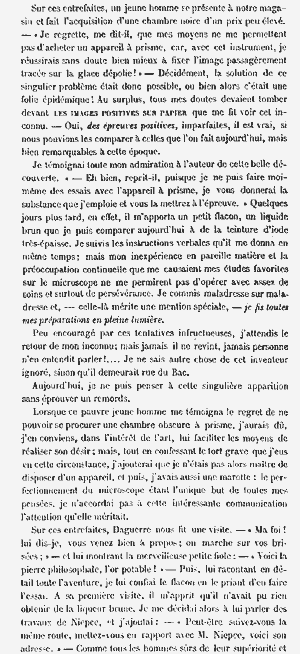
Chevalier's account of his meeting with the unknown inventor.
The new names
We have seen the list of inventors who came forward in 1839, and it may be of interest to arrange them in chronological order:
- January 20: Bayard (silver iodide)
- January 25: H. F. Talbot (silver chloride)
- January 29: Sir William Herschel (fixing with sodium hyposulfite, silver carbonate)
- February 1: Steinheil and Kobell (silver salts)
- February 2: Gerber (silver salts)
- February 11: Desmarets (silver salts)
- February 24: Vérignon (silver iodide)
- March 2: Friederike Wilhelmine von Wunsch (silver salts)
- March 9: Rev. J. B. Reade (silver chloride)
- March 9: Samuel F. B. Morse (silver salts)
- April 8: Lassaigne (silver iodide)
- April 9: Breyer (reflectographic process)
- April 17: Fyfe (silver phosphate)
- May 25: Mungo Ponton (chromium salts)
- August: Hans Thoger Winther (silver salts)
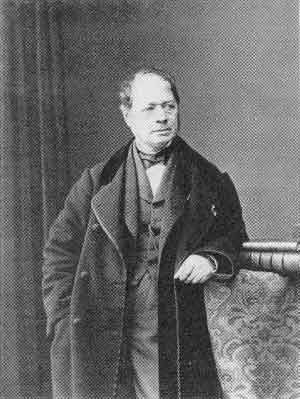
Portrait of Hippolyte Bayard, probably by himself, made after 1863. Collections of the Société Française de Photographie.
17 For the sake of completeness but, unfortunately, without being able to give any details of the techniques they used, we must mention the names of the German Liepmann, of another German Hoffmeister, of the Spaniard Zapetti and the Brazilian Florence (the latter being quoted without further particulars by M. B. Nogueira 18 in his Almanaque Portuguès de Fotografia 1958 p. 77). Finally, certain authors have wished to include in this list the names of J. W. Draper and Karl Emil Schafthäutl, but the sources are uncertain 19 20.
I wish to add another who, however, published nothing, who remained silent or did nothing that might lead people to suppose that he had any share whatever in the discovery of the New Art, and yet I feel that he is always there, close to Daguerre: a chemist whose name has already been mentioned, viz. Jean Baptiste Dumas.
After reading the biography which was devoted to him by his grandson, General Dumas, and of which a typewritten copy can be found in the Réserve des Imprimeries of the Bibliothèque Nationale in Paris 21, and after comparing other texts 22, one is gradually led to the conclusion that Dumas gave Daguerre the essential knowledge he lacked. He 'helped him', to say no more, 'materially and scientifically', as General Dumas puts it. By way of advice he suggested that he should use sodium hyposulfite, discovered by Herschel in 1819, as a solvent of the silver salts so as to obtain better stabilization of his pictures 23.
Before we can allot to each the share which is his due, it must be said that the parts played were very unequal. History has judged, but that is not the important point for the simple reason that the only judge was Arago. Objectively seen, it is possible to place the preceding names in three categories according to whether the facts revealed in 1839 were already known, whether they represented new solutions or whether they showed the way to different techniques.

Negative on paper made by H. Bayard and forming a theme frequently recurring in his experiments. It is amongst his very earliest attempts but it is now so damaged that it has become impossible to reproduce it. Collections of the Société Française de Photographie.
- 1. Report of the Académie des Sciences, 1st sem., 1839, pp. 4-7. ▲
- 2. The agreement was signed on December 14, 1829, and Niépce attached to it an account of the methods he used to obtain his pictures, an account which is dated December 5. ▲
- 3. See the 'Journal des Artistes' of September 27, 1835. This date is later than that of the signature of the Supplementary Agreement with Isidore Niépce (May 9, 1835). ▲
- 4. This 'prospectus', probably a unique document, was found again by Gabriel Cromer. It is now preserved at the George Eastman House and the text of it was published in the Bull. Soc. Fse Photog., March 1935, pp. 70-72 and in fac-simile in 'Image' March 1959, pp. 33-34. ▲
- 5. See the letter from Daguerre to I. Niépce of January 2, 1839, preserved in the Archives of the Academy of Sciences of the USSR and published in "Dokumentii po istorii izobreteniia Forografii', 1949, document No. 152; 'At last I have seen M. Arago (...) as I have been able to see for myself since I have shown my prints, the subscription would not attract funds (...). The word subscription scandalizes everybody.' ▲
- 6. The sentence that seems crucial to me in Schulze's text is the following: 'Vitrum pro maxima sui parte opacis corporibus obtegerem, relicta exigua portione quae liberum luci assessum permitteret. Sic non rara nomina vel integras sententias chartae inscripsis et atramento notatas partes scalpello acuto caute exscidi, et sic sententias sedimento cretaceo tam accurate et distincte inscriberent ut multis curiosis, experimenti autem nesciis, ad nescio quod artificium rem hanc referendi occasionem subinde dederim' Published in the 'Acta physicomedica, Academiae Caesarae Leopoldina Carolina', 1727, pp. 528 sq. ▲
- 7. "Tom Wedgwood', by R. B. Lichtfield, London, 1903, 'Journals of the Royal Institution', Vol. 1, June 1802, pp. 170-174. The note edited by Davy concludes thus: 'Nothing but a method of preventing the unshaded parts of the delineation from being colored by exposure to the day is wanting, to render the process as useful as if it elegant.' ▲
- 8. 'Tom Wedgwood', by R. B. Lichtfield. Appendix B and 'Le Rayon Bleu' of January 15, 1869. ▲
- 9. Tiphaigne de la Roche: 'Ciphantie.' La Haye (1761) according to the copy in the Bibl. Nat. Paris. ▲
- 10. Fénelon: 'Un voyage supposé', story of 1690. ▲
- 11. A. Cellio: 'Descrizione di un nuovo modo di trasnportare qual sia figura disegnata in carta, medianti i raggi solari.' Rome, 1686. ▲
- 12. Alléon Duval: 'Mélanges d'Histoire naturelle', 1765. ▲
- 13. Gaumé described his process by decoloration in the Bull. Soc. Fse Photog., 1881, p. 58. ▲
- 14. Arthur Chevalier: 'Étude sur la vie et les travaux scientifiques de Charles Chevalier.' Paris, 1862. See pp. 143-144. ▲
- 15. The ms., which is still unpublished, is at present the property of M. Monnet, Mayor of Breteuil-sur-Noye (Oise). It reads: '... In 1830 (...) he called shyly on the Chevalier brothers, the famous Paris opticians, and inquired the price of a new model of camera obscura, and he showed to the Chevalier brothers a view of the roofs of Paris which was neither a drawing nor a painting, fixed with a brown liquid. He went away again without giving either his occupation or his address.' ▲
- 16. It is not without interest to recall a note inserted in the 'Journal des Artistes' from the pen of a certain Hubert, September 11, 1836. He writes that, having been engaged in a series of investigations for seven or eight years of which he has spoken to his friends, he had experienced the difficulty of taking views with the camera obscura; he too had therefore discovered a process of making the most perfect portraits. Is is curious that Hubert never disclosed anything either, at least not according to the sources I have consulted. very little is known about him except that he was a daguerreotypist of the very first rank. It must be added that he was to die very early, in 1840, and could not join in the controversy between the younger Niépce and Daguerre. Hubert intimates that his own experiments go back to 1828. This brings us close to the date mentioned by Chevalier. ▲
- 17. In this list Henry Fox Talbot is of course named but will not be studied in greater detail afterwards: his contribution calls for no discussion. He must be placed on the same level as Niépce and Daguerre. ▲
- 18. M. Nogueira gives this simple sentence without further reference: 'Em 1833 no Brasil (Sao Paulo) Hércules Florence obtém as suas primeiras imagens fotograficas sobre chapa metàlica, mas tamben naô as consigue fixar perfeitamente, o mesmo a contencendo a Lipman (Berlin) e Breyer (Liège).' ▲
- 19. It seems difficult to include Draper in this list, but it may rightly be said that he was one of the very first to practise photography in the Unisted States. As for Schafthäutl, Erich Stenger says: 'Auch andere, so Z. B. der Deutsche Dr. Karl Emil Schafthäutl (1803-1890), arbeiteten in ähnlicher Weise, ohne daß diese Verfahren Bedeutung erlangen." (Siegeszug der Photographie, p. 13.) ▲
- 20. Finally certain authors have quoted the names of Petzhold and Enzmann among those who commended photographic methods in 1839. ▲
- 21. General J. B. Dumas, typescript preserved at the Bibl. Nat., Paris (Rés. Fol. Ln 27.80325, pp. 105-106). ▲
- 22. Pierre G. Harmant: 'Document inédit pour servir à l'histoire du daguerréotype', information leaflet Soc. Fse Photog. Nov./Dec. 1958. ▲
- 23. See in this connection: 'Gelehrete Anzeigen' of July 3, 1839, p. 16. ▲